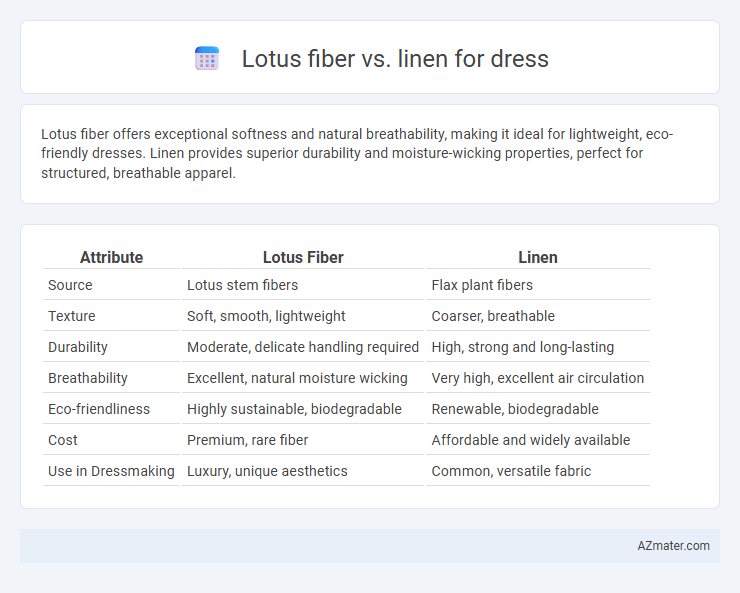Lotus fiber offers exceptional softness and natural breathability, making it ideal for lightweight, eco-friendly dresses. Linen provides superior durability and moisture-wicking properties, perfect for structured, breathable apparel.
Table of Comparison
| Attribute | Lotus Fiber | Linen |
|---|---|---|
| Source | Lotus stem fibers | Flax plant fibers |
| Texture | Soft, smooth, lightweight | Coarser, breathable |
| Durability | Moderate, delicate handling required | High, strong and long-lasting |
| Breathability | Excellent, natural moisture wicking | Very high, excellent air circulation |
| Eco-friendliness | Highly sustainable, biodegradable | Renewable, biodegradable |
| Cost | Premium, rare fiber | Affordable and widely available |
| Use in Dressmaking | Luxury, unique aesthetics | Common, versatile fabric |
Introduction to Lotus Fiber and Linen
Lotus fiber, derived from the stalks of lotus plants, offers exceptional breathability and sustainability, making it a unique choice for eco-conscious fashion. Linen, made from flax fibers, is renowned for its durability, lightweight texture, and natural moisture-wicking properties, widely used in garments for hot climates. Both fibers provide breathable fabrics ideal for dresses, but lotus fiber stands out for its rarity and environmental benefits compared to the more common and affordable linen.
Origins and Production Processes
Lotus fiber, derived from the stems of lotus plants native to Southeast Asia, undergoes a labor-intensive extraction process involving careful harvesting, drying, and hand-stripping to obtain fine, silky threads ideal for breathable dress fabrics. Linen, made from the flax plant predominantly grown in Europe and parts of Asia, is produced through retting, drying, and mechanical or manual spinning that transforms flax fibers into durable, textured yarns commonly used in dressmaking. Both fibers emphasize sustainable, natural origins, but lotus fiber's unique extraction method results in a lightweight, glossy fabric, contrasting with linen's characteristic crispness and resilience.
Environmental Impact Comparison
Lotus fiber and linen are both sustainable fabrics, but lotus fiber offers a lower environmental impact due to its natural extraction process that requires minimal water and no chemical treatments. Linen, derived from flax plants, uses less water than cotton but still involves retting and processing methods that can generate wastewater and require energy. Choosing lotus fiber promotes biodiversity and reduces the carbon footprint associated with conventional textile production, making it an eco-friendlier option for dress materials.
Texture and Comfort for Dresses
Lotus fiber offers a unique, silky texture that is lightweight and breathable, making it ideal for comfortable, airy dresses in hot climates. Linen, derived from flax plants, provides a slightly rougher texture with excellent moisture-wicking properties, ensuring durability and coolness. Both fibers promote comfort but differ in texture, with lotus fiber delivering a smoother feel and linen offering a more textured, rustic aesthetic.
Durability and Longevity
Lotus fiber offers exceptional durability due to its strong cellulose content, making it resistant to wear and tear compared to traditional linen. Linen, derived from flax plants, is also known for its long-lasting qualities but tends to lose strength faster with frequent washing. Both fibers provide excellent breathability, yet lotus fiber typically ensures a longer lifespan for dresses due to its naturally resilient structure.
Breathability and Moisture Wicking
Lotus fiber offers superior breathability compared to traditional linen, making it ideal for hot and humid climates. Its natural micro-porous structure enhances moisture wicking, keeping the skin dry and comfortable throughout the day. While linen is breathable and moisture-wicking, lotus fiber's unique composition provides enhanced airflow and quicker evaporation, offering better temperature regulation in dresses.
Dyeing and Color Retention
Lotus fiber exhibits exceptional dye absorption due to its natural cellulose structure, resulting in vibrant and long-lasting colors ideal for dressmaking. Linen, made from flax fibers, also retains dye well but tends to fade faster under prolonged sunlight exposure compared to lotus fiber. The superior color retention of lotus fiber dresses ensures sustained brightness and reduced fading, making it a preferred choice for high-quality dyed garments.
Price and Availability
Lotus fiber is significantly rarer and more expensive than linen due to its labor-intensive extraction process and limited production primarily in Southeast Asia. Linen, derived from flax plants, is widely available and more affordable, with established global supply chains supporting mass production. For dressmaking, choosing lotus fiber offers exclusivity and sustainability at a premium price, whereas linen provides cost-efficiency and broader accessibility.
Suitability for Different Dress Styles
Lotus fiber offers a unique, lightweight texture ideal for flowing, bohemian-style dresses that require breathability and softness, while linen excels in structured, tailored suits and summer dresses due to its crispness and durability. Lotus fabric's natural sheen enhances elegant, draped silhouettes, making it suitable for evening wear and casual chic ensembles. In contrast, linen's moisture-wicking properties and firm weave provide classic lines and a polished appearance perfect for formal and professional attire.
Conclusion: Choosing the Best Fabric
Lotus fiber offers exceptional eco-friendliness and a unique texture, while linen is prized for its durability and breathability. For sustainable fashion, lotus fiber is ideal due to its renewable sourcing and natural strength. Those seeking a time-tested, versatile fabric with proven comfort may prefer linen for everyday wear.

Infographic: Lotus fiber vs Linen for Dress
 azmater.com
azmater.com